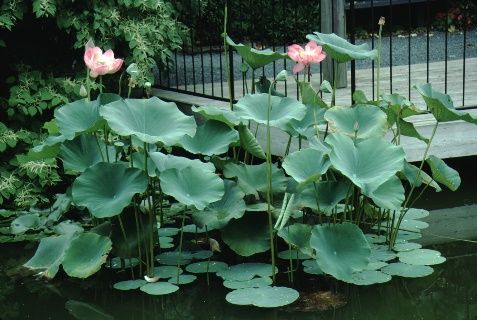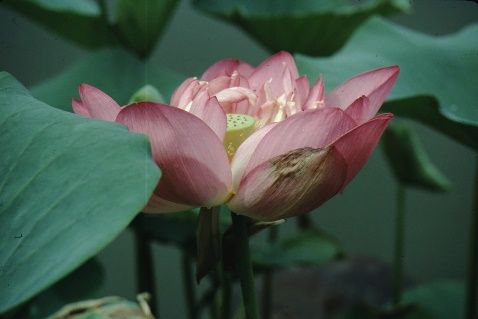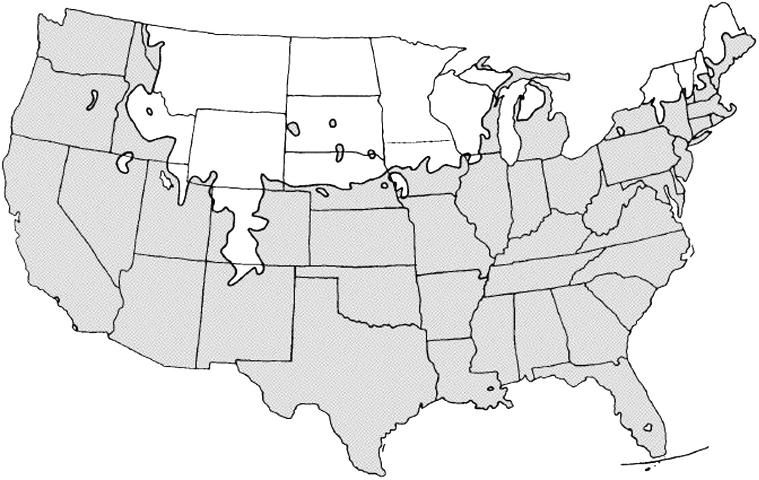Introduction
Lotus is a non-native aquatic plant requiring plenty of space and a full sun location to thrive. It is nothing less than spectacular in bloom, the soft pink blossom up to 8 inches across, opening on top of a stiff stalk emerging directly from below the water. The easily recognized, large fruit structure develops as the flower opens and turns brown when the flower fades and the petals fall into the water. Leaves are enormous, sometimes reaching 2 feet across. The fruit is often used by professional florists in dried arrangements.

Credit: Edward F. Gilman, UF/IFAS

Credit: Edward F. Gilman, UF/IFAS
General Information
Scientific name: Nelumbo nucifera
Pronunciation: nee-LUM-boe noo-SIFF-fer-ruh
Common name(s): lotus, sacred lotus
Family: Nelumbonaceae
Plant type: aquatic plant
USDA hardiness zones: 5 through 10 (Figure 3)
Planting month for zone 7: year-round
Planting month for zone 8: year-round
Planting month for zone 9: year-round
Planting month for zone 10: year-round
Origin: not native to North America
Invasive potential: potentially invasive
Uses: water garden
Availability: somewhat available, may have to go out of the region to find the plant

Credit:
Description
Height: 5 to 8 feet
Spread: 4 to 8 feet
Plant habit: upright
Plant density: open
Growth rate: fast
Texture: coarse
Foliage
Leaf arrangement: most emerge from the soil, usually without a stem
Leaf type: simple
Leaf margin: undulate
Leaf shape: orbiculate
Leaf venation: palmate
Leaf type and persistence: deciduous
Leaf blade length: 18 to 36 inches
Leaf color: green
Fall color: no fall color change
Fall characteristic: not showy
Flower
Flower color: orange; yellow
Flower characteristic: summer flowering
Fruit
Fruit shape: round
Fruit length: 3 to 6 inches
Fruit cover: dry or hard
Fruit color: brown
Fruit characteristic: persists on the plant
Trunk and Branches
Trunk/bark/branches: typically multi-trunked or clumping stems
Current year stem/twig color: not applicable
Current year stem/twig thickness: not applicable
Culture
Light requirement: plant grows in full sun
Soil tolerances: acidic; grows submerged in water
Drought tolerance:
Soil salt tolerances: unknown
Plant spacing: 36 to 60 inches
Other
Roots: not applicable
Winter interest: no special winter interest
Outstanding plant: plant has outstanding ornamental features and could be planted more
Pest resistance: long-term health usually not affected by pests
Use and Management
Lotus plants are extremely aggressive and should be planted into containers in the water garden to keep them from escaping and permanently rooting into the soil beneath the water. Once they become established in the soil, they are difficult to get rid of. Containerizing plants is a good way to enjoy lotus without the danger of them becoming invasive in the pond or lake.
Lotus should be planted in a container filled with garden soil or potting mix. A shallow and wide container is better than a tall, narrow container. The garden soil can be mixed with one-fifth well-decomposed cow manure. Incorporate fertilizer at an equivalent rate of about one-quarter cup 10-10-10 per gallon of soil or media to help stimulate growth. Before filling the container, place a small plastic bag filled with sand at the bottom to keep it from floating in the pond. Plant the rhizome at the edge of the container so it can grow horizontally across the top. Place a 1 or 2 inch layer of sand or gravel over the top of the media after the rhizome is planted in the pot to keep media and soil in the container. Lower the container into 6 inches of water until growth begins. Then it can be set so the bottom of the container is no more than 18 inches below the water surface. If the water is too deep, place a brick or concrete block under the container. Do not construct containers from treated lumber since growth could be severely inhibited.
Small cultivars are better suited for a smaller garden and could include 'Momo Boton' with rose-colored flowers and smaller leaves than the species. The native lotus, Nelumbo lutea has light yellow flowers and is hardy into USDA hardiness zone 4.